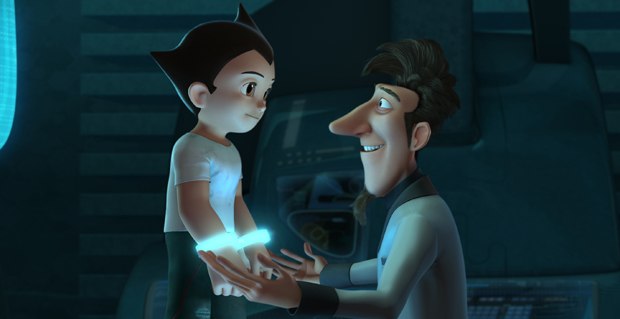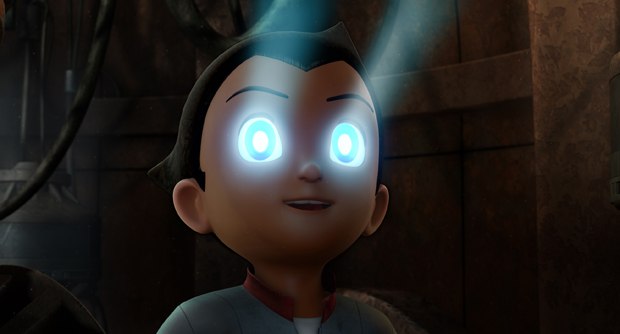Director David Bowers and Animation Director Jakob Jensen tell us all about Imagi's Astro Boy.
Check out the trailers and clips from Astro Boy at AWNtv!
Re-imagining the iconic anime hit, Astro Boy(opening today from Summit Ent.) was a daunting challenge for everyone. But apparently it was a satisfying one, despite all of the obstacles -- creative, technical and financial. It certainly raised the CG animation bar for Imagi Studios (a collaboration between studios in Hong Kong and L.A.), and provided a lot of work for animators formerly with DreamWorks, Disney and Sony. And, as director David Bowers (Flushed Away) points out, the timing couldn't be better.
"He finds out that he's not a real boy: he's a robot and his father doesn't want him anymore. I think it's mind blowing to kids to put themselves in his position. And it seemed like a good place to start and somehow carry on. I think for Astro, he just doesn't know where he fits in… and at the end of the movie, he knows where his place is as a hero."
And what was the experience like at Imagi compared to DreamWorks and Aardman?
"Well, it was great: I think when you're making a movie, you draw on a lot of experiences and I learned a lot from those two studios. Imagi is an independent studio -- it's a smaller film -- and there were no real ground rules in place, so we sort of made things up as we went. And producer Maryann Garger and Imagi were very supportive of the movie I wanted to make.
"And since Turtles, Imagi has learned a lot. There's a lot of incredibly talented people both in Los Angeles and Hong Kong. In Hong Kong, the animation was supervised by Tim Cheung, formerly with PDI and theShrekmovies, and visual effects was supervised by Yan Chen, who's the most amazing innovator, and no matter what I threw at him he'd manage to do more crowds and more explosions and a lot more atmosphere. But a lot of key positions at Imagi in Hong Kong have quite a bit of experience on major animated pictures in the United States. And my story team were all DreamWorks, Sony and Disney people. It's such a small industry.
Bower suggests that the biggest creative challenge was striking a balance between tragedy and comedy: wanting to take dark subject matter about a scientist who loses his son and replaces him with a robot, which turns out disastrously for him.
"There's something terrible about the loss of a child, and it was really taking that tragedy and making something positive come out of it and making it being an upbeat, fun and exciting movie for families. I didn't want it to be a downer and I didn't want it to be pessimistic. I think Astro Boy was born out of optimism and is much lighter in tone than, say, Batman. He's more in the line of Superman."
Bowers loves science fiction and robot and Godzilla movies, so he was thrilled to infuse Astro Boy with as much action as possible. "So it was somehow combining all of that -- and I live and breathe that kind of stuff."
As for the look, Bowers contends that it's not your typical CG-animated movie: "I think that production designer Samuel Michlap and art director Jake Rowell came up with the look of [sculptor] Noguchi for the shape and style of the buildings, and we looked at images of Mt. Fuji by Hokusai, which is represented by the mountain in Metro City. And I think it does have a unique look: we call it 'retro futurist.'
However, given the recession, there was a major setback to deal with when financing temporarily halted early this year and the L.A. studio in Sherman Oaks had to shut down. But Imagi in Hong Kong picked up the slack without a beat, according to Bowers.
"Being an independent studio and struggling to find investment and investment being pulled out was extremely challenging," he relays. "We lost a lot of crew in L.A. and encouraged them to find other work. At one point, we weren't sure the movie was going to get finished, which would've been a tragedy because everyone really loved it. But investment did come through and the movie got up and running again. We managed to finish it. But it was a struggle -- it really was. It was very draining."
Especially since Astro Boy was forced to shut down production for a month. "But, again, I don't think the film feels compromised in any way. At the end of the day, we managed to do things just the way we wanted."
Among the crew who wasn't able to finish his stint was Jakob Jensen (Flushed Away), the animation director, who went back to DreamWorks to work on How to Train Your Dragon. But for him, it was all about staying true to the story, the universe and the lore.
"But as an animator, I think if you think too much about style, you might be missing the point," he suggests. "You also don't want to copy what's been done already and force something on a story just because it's staying true to the heritage. But, as an actor, staying true to the moment is the main challenge. My key point is simplicity. I'm a big fan of simplicity. And staying true to Tezuka' s vision is in that simplicity, which is inherent in that Japanese sensibility, I suppose. And that sensibility is shared amongst many of us animators in finding the core of a performance and boiling it down to poetics."
Jensen echoes Bower's assessment of the Imagi crew: "They've obviously grown as artists and have evolved the [<Maya>-based] toolset. We injected our experiences from DreamWorks. Tim Cheung went to Hong Kong to oversee a lot of the technical issues. He implemented a lot of the workflow that you see at major studios: animation libraries and how to approach lip synch and how to streamline the process and make faces consistent from animator to animator. The funny thing is, I still consider myself a traditional animator, and it used to be one of the biggest challenges for a supervising animator to make sure the whole team stays on model. And, interestingly enough, it's still an issue even though you are given a puppet with all that technology offers to push and pull."
And what was most difficult to get right?
"The physics of flight because how do you test that? He's got rocket boots so perhaps it wasn't that challenging but we had to just figure out how to work within the laws of physics. There's a great scene when he just learns to fly. He's falling from the roof and falling and falling and falling and he gets up and the boots turn on and he's dumbfounded. And there's a long shot of him starting to figure it out. It's really well animated and we're happy the way it turned out."
In other words, it's pure Astro Boy.
Bill Desowitz is senior editor of AWN & VFXWorld.











